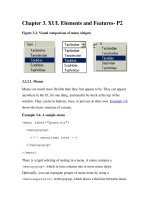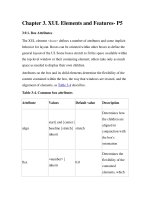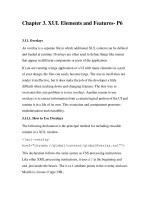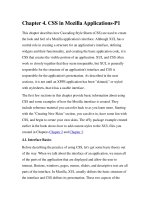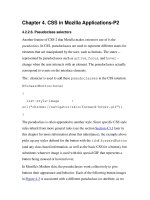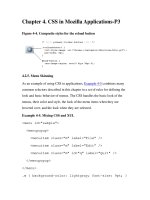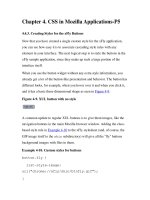Creating Applications with Mozilla-Chapter 4. CSS in Mozilla Applications-P1
Bạn đang xem bản rút gọn của tài liệu. Xem và tải ngay bản đầy đủ của tài liệu tại đây (64.3 KB, 18 trang )
Chapter 4. CSS in Mozilla Applications-P1
This chapter describes how Cascading Style Sheets (CSS) are used to create
the look and feel of a Mozilla application's interface. Although XUL has a
central role in creating a structure for an application's interface, defining
widgets and their functionality, and creating the basic application code, it is
CSS that creates the visible portion of an application. XUL and CSS often
work so closely together that they seem inseparable, but XUL is generally
responsible for the structure of an application's interface and CSS is
responsible for the application's presentation. As described in the next
sections, it is not until an XPFE application has been "skinned," or styled
with stylesheets, that it has a usable interface.
The first few sections in this chapter provide basic information about using
CSS and some examples of how the Mozilla interface is created. They
include reference material you can refer back to as you learn more. Starting
with the "Creating New Skins" section, you can dive in, have some fun with
CSS, and begin to create your own skins. The xFly package example created
earlier in the book shows how to add custom styles to the XUL files you
created in Chapters Chapter 2
and Chapter 3.
4.1. Interface Basics
Before describing the practice of using CSS, let's get some basic theory out
of the way. When we talk about the interface of an application, we mean all
of the parts of the application that are displayed and allow the user to
interact. Buttons, windows, pages, menus, sliders, and descriptive text are all
parts of the interface. In Mozilla, XUL usually defines the basic structure of
the interface and CSS defines its presentation. These two aspects of the
interface -- the way it's organized and the way it's presented -- are kept as
distinct from one another as possible in Mozilla and in many good
programming environments. Indeed, this separation is what gives rise to the
concept of skins -- coherent, separate, and typically swappable "looks" for
the same underlying structure. Mozilla uses Cascading Style Sheets, a
quickly evolving series of standards already common in HTML web page
presentation, to define the skin of XUL application interfaces.
4.1.1. Skins Versus Themes
When we say skin in this chapter, we refer to the look of the interface -- to
the CSS styles and its relationship to the XUL structure underneath. The
term theme is also used often in conjunction with interfaces and skins. These
words are used interchangeably, although there are some differences in their
meaning.
A single, overall theme is made up of many skins. The Navigator
component's skin described in navigator.css, for example, is part of
the overall Modern theme of Mozilla. Following this definition, the Modern
theme may be made up of as many as 20 or 30 different skins corresponding
to the major components and major UI features within those components. In
addition to navigator.css, for example, there are stylesheets for toolbar.css,
linkToolbar.css, and others, which collectively make up the Navigator skin.
The CSS files may also be described as skins, as when this book instructs
you to "open the messenger.css skin in a text editor." All skins of a
particular kind or look organized together comprise a single theme.
Themes are also often used to refer to the different looks that you can
download and install for Mozilla and Netscape 6.x and 7.x. (To get new
themes for the Mozilla browser go to View > Apply Themes > Get New
Themes.) Any application created with Mozilla, though, can have different
themes that users can install and select to customize the look of that
application.
This distinction between a skin and a theme is not enforced -- or even
acknowledged -- by many people in the Mozilla community, so you will see
a profligate use of these terms in practice. Try to remain calm. The
terminology differences aren't important. What is important is that you can
create one (or many) looks for your application using CSS. This chapter will
show you how.
4.1.2. Limitations of a Skin
Skins are used to style the structure of an interface that has been created with
XUL. Once the interface has been defined in XUL, that structure is set and
CSS can be used to change how that structure will look, but can't be used to
change the structure itself. In practice, this means that you can use CSS to
change the way a button looks -- but to move a button from one toolbar to
another within the interface, you need to edit your XUL code. Skins
generally affect the usability or appearance, but not the functionality of an
interface, though the use of XBL in CSS is an exciting exception to this rule,
as you will see.
This separation of the style and the content of an application means that
there are a number of things you can't change in an application using CSS.
Here are some examples of the kinds of interface elements that cannot be
manipulated with a skin.
•
The position and contents of menus and menu items and the
functionality they trigger.
•
The overall layout and functionality of buttons.
•
The general layout of the application (although you can use CSS to
hide sections of an interface).
While the underlying structure of menus and buttons cannot be changed in
the process of editing a theme, you can, of course, change the appearance of
things quite radically. In fact, you can change whether an element -- say, an
item in a menu -- has any visibility using the visibility or display
CSS properties. One of the Mozilla extensions to CSS, -moz-box-
ordinal, lets you set the order in which the elements in a container are
displayed. We describe these extensions and others later in this chapter in
the section Section 4.2.3
.
4.1.3. Theme Abstraction (or Building Good Skins)
One of the most important parts of a well-written theme is that it be as
separate as possible from the actual structure of the interface -- that it be
abstracted as a layer so it can be switched or updated without affecting or
forcing you to edit the underlying XUL. Keeping an application's style
separate is not mandatory, however, and you can have all presentation code
in your XUL files, although we explain why this isn't a good idea.
As we have tried to stress, at the most basic level, abstraction means that the
XUL should describe the structure and the CSS should describe the
presentation, or look, of the interface. In reality, of course, the presentation
layer is itself divided into different layers, where lower, more basic files like
xul.css describe the look and feel of common UI elements such as buttons
and menus, and higher-level CSS files consistently describe the layout and
stylistic details of a component. When working on a theme or skin for your
application, you should use as few inline style attributes as you can, as well
as ensure that your themes are organized into component subdirectories and
that one skin does not depend on another that is farther down in the "skin
hierarchy." (This is discussed later in this chapter in the Section 4.3.1
section.).
Planning Your Interface
Before you begin using CSS and images to style your XUL application code,
it's important to have a sense of where your interface is heading. Begin by
asking yourself some questions. What should the buttons look like? Do you
want to give users the ability to switch skins in your application, as they can
in the Mozilla browser? How will your application be affected when the user
switches skins in Mozilla? What, if any, are the differences on the different
platforms on which you expect users to run your application?
Although creating interfaces using XUL and CSS is fun and fast, it's best to
do a mockup of your interface before you begin so you know where you are
heading (both Adobe Photoshop and the GIMP are excellent tools for
creating sophisticated images and mock-ups). The creators of the Modern
and Classic themes do lots of visualization of the themes in image editing
software and go through several iterations of testing and feedback.
One of the great advantages of using such an approach is that you will
undoubtedly develop images and icons for your interface anyway, and you
can slice and dice your mockup to get, for example, the icons for your
buttons, the background images, and other real parts of the interface. You
may find that you can actually use most of the mockup in your actual
interface! See Section 4.2.4
later in this chapter for an explanation of how
this image slicing can work in an advanced way when you have XBL-based
widgets that use GIF images that are stitched together.
Because the overall theme of an application will most likely consist of a
large number of individual graphic elements and widgets, pay special
attention to considerations of color palette, web-optimized file formats such
as .gif and .png, and file size to make sure your interface looks good and
loads quickly.
4.1.4. Cross-Platform Interface Considerations
Often in traditional interface development, you try to make things look and
work right on a single platform. Using something like MFC on Windows,
for example, you can drop in the widget it provides and be reasonably
assured that the interface will look like a Windows application interface
whenever and wherever your application is run.
When you do cross-platform user interface development, you need to be
aware of how your application will look on the platforms on which it will be
used. One common difference, for example, is the layout of scrollbars in
Windows applications and in Macintosh applications. On Windows,
scrollbars typically have buttons at either end that advance the scrollbar
button itself. On the classic Macintosh, the scrollbars are configured so that
the buttons are clustered together. The difference is subtle, but it is a source
of huge contention in the Mozilla world. Figure 4-1
shows the difference
between the scrollbars on the two platforms. (This figure also shows a small
notch in the lower righthand corner that is part of all classic Macintosh
application windows and that shifts part of the Mozilla interface over to the
left.)
Figure 4-1. Scrollbars on Windows and on the Macintosh
When you use the XPFE, you use a single code base to deploy on any
number of different platforms. In the Mozilla code, there are some tricks for
making things work differently on different platforms. Like scrollbars, the
layout of buttons in dialogs is another important area of platform difference.
The layout code for the Open Web Location dialog, for example, is defined
in platform-specific files, and slightly different dialog layouts are deployed
transparently to users (depending on their platform). Figure 4-2
illustrates
the differing layouts of this dialog on different platforms (note the different
positions of the Open and Cancel buttons in the two images).
